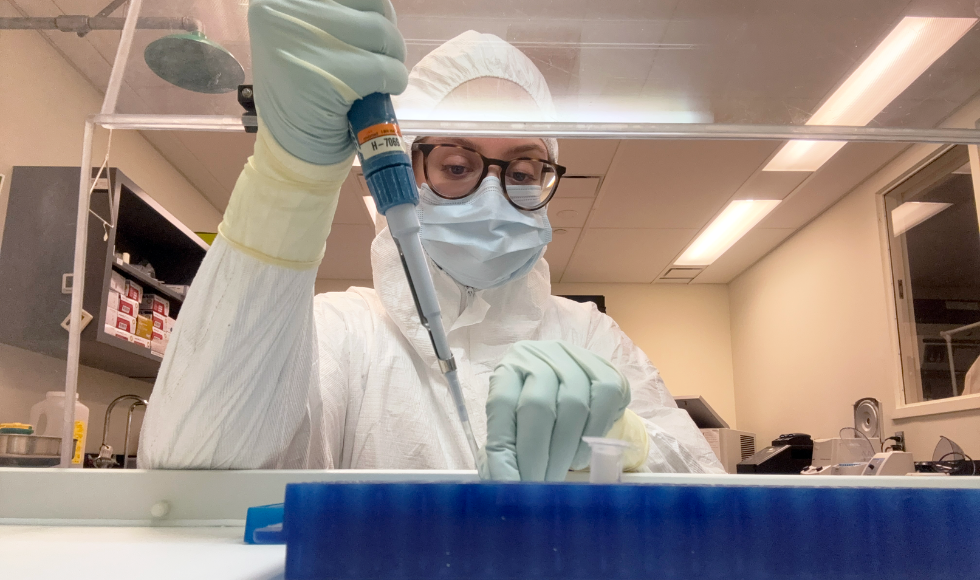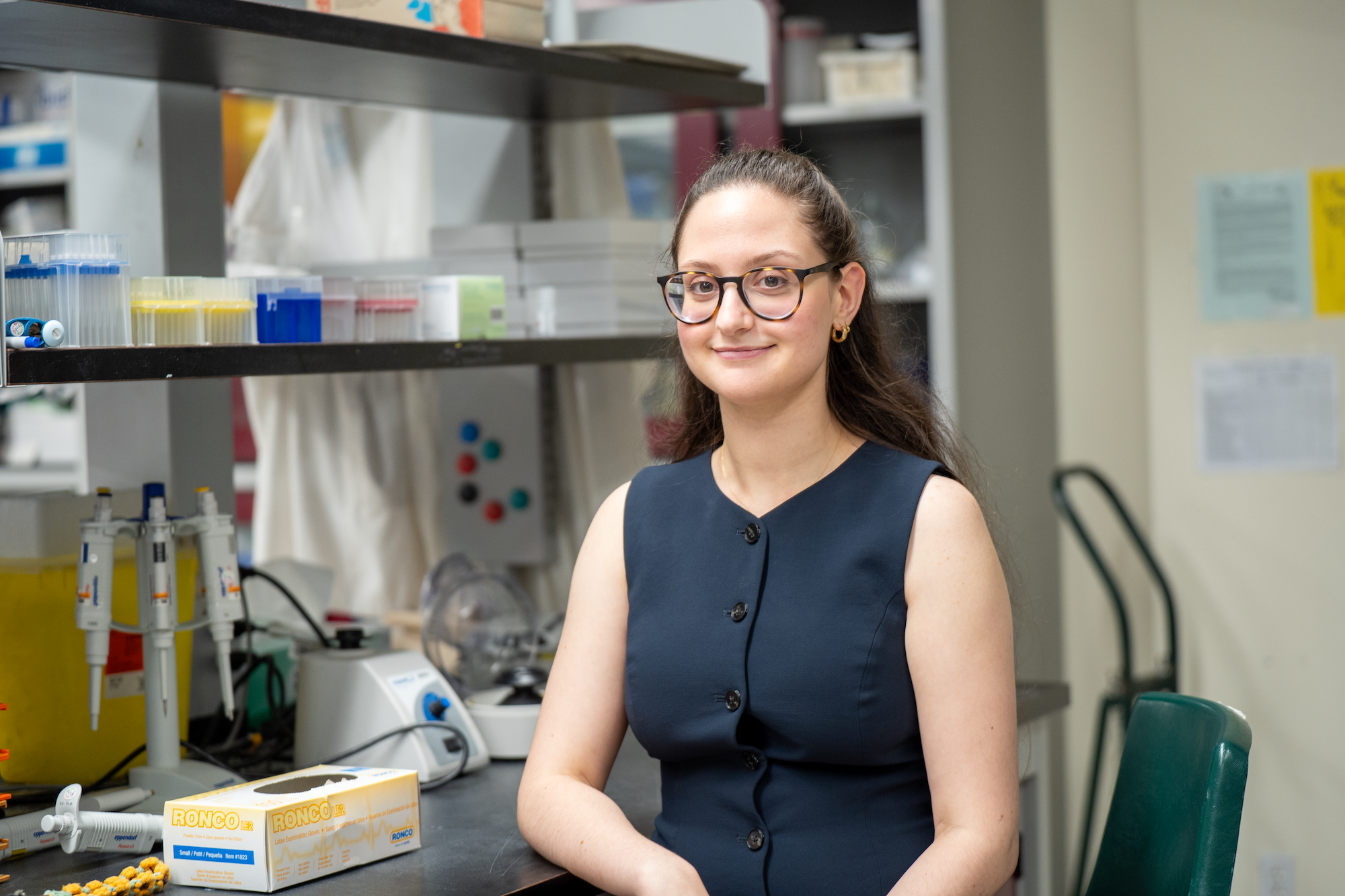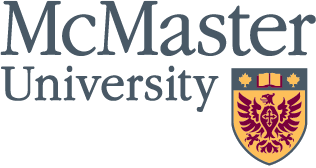Hannah Campeau is looking for the plague

Campeau, a recipient of an Undergraduate Student Research Award, is spending the summer working in the Ancient DNA Centre. She's searching for Yersinia pestis, the bacterium that causes bubonic plague, in ancient human teeth. (Photo by Chris Pickles)
BY Caelan Beard
August 7, 2025
Inside a sealed lab, wearing two pairs of gloves, a face mask, and clean room suit to prevent contamination, Hannah Campeau is extracting ancient DNA from a 3000-year-old tooth.
She’s looking for the plague.
Campeau, a recipient of an Undergraduate Student Research Award, is spending the summer working in evolutionary geneticist Hendrik Poinar’s lab in the Ancient DNA Centre.
Poinar and PhD candidate Ravneet Sidhu, along with colleagues from France’s Institut Pasteur, recently published a study on the bubonic plague in the journal Science.
That study documented the way that a single gene in Yersinia pestis, the bacterium that causes bubonic plague, allowed it to survive hundreds of years by adjusting its virulence and the length of time it took to kill its victims.
Campeau, who recently graduated with concurrent degrees in Biochemistry and Anthropology, worked with Poinar for her fourth-year thesis, which focused on plague evolution in the Bronze Age.
The USRA project she’s working on now is largely a continuation of that thesis work: She’s looking at samples from sites in the Near East, during the Late Bronze Age and Early Iron Age period, and screening them for Yersinia pestis. She spends most days in the lab, looking for pestis in ancient human teeth.
Previous studies, like the one published in May 2025, have looked at different strains of pestis which acquired the gene that allowed it to rapidly spread. “We’re trying to narrow down the time frame and geographical range to see when the bacterium would have acquired a particular gene,” Campeau said.
The process requires drilling into the teeth, extracting the DNA, screening for gene targets using a PCR machine, constructing a DNA library, and – finally – sequencing the DNA within so that the researchers can determine its identity.
It’s very repetitive work. People would probably be surprised by how much analysis goes into each and every sample, Campeau said.

They might also be surprised to learn that Campeau doesn’t always expect to find anything – she tries to keep her expectations low. She might be going in with contextual cues, such as bioarcheological or historical evidence, but that doesn’t guarantee she’s going to find something informative.
“I could look in all the right places and never find plague,” Campeau said. “This could be because there is no longer genetic material to be found, or that the conditions weren’t right for me to find what we were looking for.”
There’s a certain ‘needle-in-the-haystack’ aspect to this work: It’s high-risk, high-reward.
Early exposure to research
Campeau credits the anthropology department for introducing her to many different types of research during her undergraduate degree.
That includes experiences with the Archaeology Teaching Lab; interdisciplinary researcher Tracy Prowse; and biological anthropologist Amanda Wissler.
“They were amazing at getting students involved in research pretty early on,” Campeau said.
Campeau was particularly interested in osteology (the study of bones), evolution and infectious disease. This brought her to reach out to Poinar and the Ancient DNA Lab, where she did her third-year research project on mammoth samples, then her thesis, and now her USRA work.
“There’s something so fascinating about being able to sample ancient specimens and collect genetic information,” Campeau said. “Genetic information tells us so much.”
Having an educational background in anthropology gives her an even more nuanced perspective in her biochemistry work, Campeau said.
Ancient DNA work can come with difficult ethical questions, many of which have historically been ignored, she said. Researchers rely on proxy consent when they’re working with human remains, like teeth – consent might come from direct descendants or a government, but that might not reflect what the individual’s wishes would have been. Additionally, sequencing genetic information could mean that it’s used by other people, and even companies, who can gain access to genetic banks and possibly find ways to monetize it. “Genetic information is an intimate part of yourself,” Campeau said.
Having this perspective on bioethics is something she values, and she’s a huge proponent of people trying things outside of their major. “People can be kind of nervous to take classes outside of their comfort zone,” she said. “There are pros to learning things outside of your general interests. And I might as well take advantage of university by doing all those things…. to learn as much as I possibly can.”
A little bit about a lot of different things
Campeau is the only undergraduate student in Poinar’s lab. She works alongside graduate students from anthropology, biology, and biochemistry.
“Everyone one of them has taught me something,” she said. “They’re amazing. I have a very supportive lab.”
In their shared workspace is a ‘wall of accomplishments,’ with sticky notes shouting out good news and wins. Campeau’s name appears on several.
Her latest win: Campeau is starting a master’s in biochemistry this fall, supervised by Poinar.
Her work will still be under the umbrella of ancient DNA, but “there’s a lot under that umbrella,” Campeau said. “I am someone who likes to know a little bit about a lot of different things.”
Her graduate thesis may investigate ancient viruses, or different bacteria than Yersinia pestis. She’s also interested in methodology and different biochemical techniques. Mostly, Campeau is excited for the opportunity to continue to explore.




